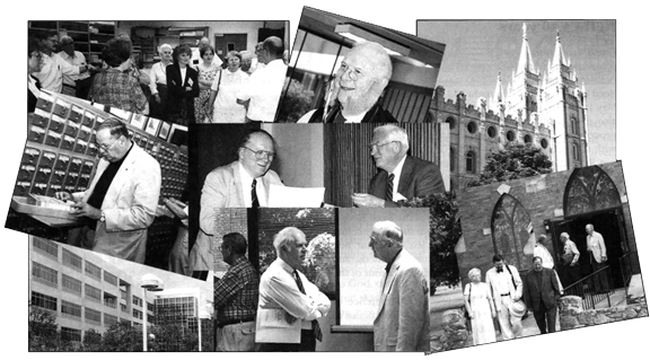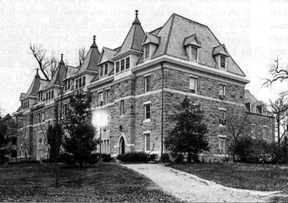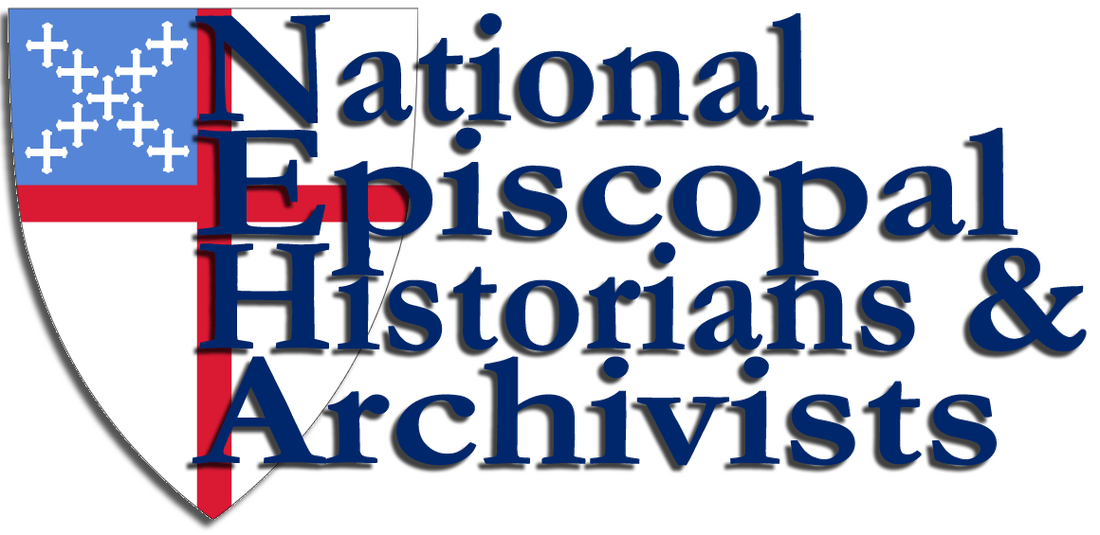NEHA: 40 years of service to the ChurchBy Robert G. Carroon, From The Historiographer, Spring 2002, Vol. XL, No. 2
Arthur Ben Chitty called first NEHA meeting. The concept of a national organization for historians, archivists, and registrars of the Episcopal Church was formulated late in 1960 by Dr. Arthur Ben Chitty. In his capacity as ambassador for higher education in the Episcopal Church and the University of the South, of which he was also historiographer, Ben (or ABC as he frequently signed himself) visited many dioceses and parishes throughout the country. As a result of those visits, he concluded there was a great deal of historical material lying about in dioceses and parishes but, as he put it, “much misunderstanding about what should be done to preserve this material.”[1] |
 In accordance with its early decision to rotate meeting places — once every triennium at the General Convention, once at the Archives of the Episcopal Church in Austin and once at an interesting place previously unvisited — in its 40-year history, NEHA has met in cities from coast to coast. Over the past 10 years [1993-2002], it has met in Cambridge, Oklahoma city, Washington, Austin Salt Lake city, Pittsburgh, Seattle, St. Augustine, Las Cruces. In 2001, it crossed national borders and met in Toronto with the Church Historical Society, the Episcopal Women's History Project, and the Candian Church Hisotrical Society.
In accordance with its early decision to rotate meeting places — once every triennium at the General Convention, once at the Archives of the Episcopal Church in Austin and once at an interesting place previously unvisited — in its 40-year history, NEHA has met in cities from coast to coast. Over the past 10 years [1993-2002], it has met in Cambridge, Oklahoma city, Washington, Austin Salt Lake city, Pittsburgh, Seattle, St. Augustine, Las Cruces. In 2001, it crossed national borders and met in Toronto with the Church Historical Society, the Episcopal Women's History Project, and the Candian Church Hisotrical Society.
After talking with several historiographers in the south, particularly Fadjo Cravens, Jr., of Arkansas, Charles Edward Thomas of Upper South Carolina, and Nash Burger of Mississippi, Dr. Chitty approached the Rev. Massey H. Shepherd, Jr., director of the Graduate School of Theology at the University of the South, professor of Liturgics at the Church Divinity School of the Pacific, and at that time also president of the Church Historical Society, for guidance in setting up an informal meeting of historiographers, archivists, and registrars for late summer, 1961. Ben's intention was to ask the participants to do some "brainstorming" around several topics, including discovering both the sort and extent of the various diocesan archives and exchanging ideas on the activities of diocesan archivists and historiographers. He thought the conference would be more inviting if several historians and archivists could be present to give lectures on basic church history and elementary archives. Ben asked the bishops to recommend the conference to their archivists and historiographers and to give him names of persons in their dioceses who might like to attend.[2]
In accordance with its early decision to rotate meeting places — once every triennium at the General Convention, once at the Archives of the Episcopal Church in Austin and once at an interesting place previously unvisited — in its 40-year history, NEHA has met in cities from coast to coast. Over the past 10 years [1993-2002], it has met in Cambridge, Oklahoma city, Washington, Austin Salt Lake city, Pittsburgh, Seattle, St. Augustine, Las Cruces. In 2001, it crossed national borders and met in Toronto with the Church Historical Society, the Episcopal Women's History Project, and the Candian Church Hisotrical Society.
Ben was pleasantly surprised to receive responses from 20 bishops and 35 historiographers, which made the conference a definite “go.” One fact that emerged was that Ben’s letter had stimulated a number of bishops to appoint historiographers for their dioceses, a plus before a conference had even been held and it showed the organizers they had identified a real need and interest in the Church. In his response to Dr. Chitty, the Rt. Rev. Wilburn C. Campbell wrote, “Thank you for calling my attention to the fact that we do not have a historiographer for the Diocese of West Virginia. I have hastened to correct this oversight...” The Rt. Rev. Alfred Vogeli of Haiti wrote, “I think your interest and the endeavor to organize the information that exists in the whole Church is a very wise one indeed. Interestingly enough, I was discussing this matter with Bishop Higgins in Rhode Island just nine days ago.” And the Rt. Rev. Frederick Warnecke of Bethlehem wrote, “... Just recently in acquiring new diocesan offices we have provided a room for archives, and we are trying to bring together various historical materials.”[3]
Historiographers themselves hastened to support such a conference. These included some of the most prominent scholars in the field of diocesan and general church history. Dr. Allen D. Breck of Colorado responded, “I certainly want to be a part of the organization, and I think that together we might raise a considerable amount of enthusiasm... I see no better way by which we can accomplish the mission of historian in the American Church.” The Rev. Lawrence L. Brown of the Church Historical Society in Austin, Texas, wrote, “If it is possible for me to work it in, I would be delighted to attend the meeting.” Edgar Acre of South Dakota said, “Am interested in the possibility of forming an organization. . . .” The Rev. Wesley Twelves of Pennsylvania wrote, “Bishop Hart would like me to represent the diocese at the meeting you have in mind...I would like to be kept informed.” With the encouragement of such well-known historians as the Rev. George E. DeMille of Albany and the Rev. Thomas E. Jessett of Olympia, Ben decided to proceed with the conference and the weekend of August 18-20, 1961, was selected as the time for the meeting, which would be at the University of the South.[4]
Arthur Ben Chitty was the host for this gathering. Each registrant was asked to make a $3.00 non-refundable deposit and on arrival to pay a registration fee of $15.00. This fee covered room, meals, and all incidental costs of the conference, beginning with Thursday night’s registration through Sunday breakfast. Although most in attendance were paying their own way, in some cases bishops were picking up the tab for their historiographers or registrars.
The theme of the first “Conference of Historiographers” was dedicated to “finding out what we ourselves are doing.” There were to be no “visiting firemen,” as Ben Chitty put it, and no “profound discourses.” Topics to be covered, largely in panel discussions, included “The Function of the Historiographer,” “The Historiographer of the Diocese: Researcher, Writer, Collector, Instigator, Publisher, Organizer,” and “How Can Historiographers Best Serve the Church?” The question, “Shall we organize?” was also addressed. Despite Ben's statement about no “visiting firemen,” one was present-Massey Shepherd addressed the group at dinner on Friday, August 18.
Present, in addition to Dr. Shepherd and Dr. Chitty, were historiographers Rucker Agee (Alabama), Allen Breck (Colorado), Lawrence Brown (Texas), Nelson Burr (Washington), Thomas Jessett (Olympia), Harold Kelley (California), Nelson Rightmyer (Maryland), William Robinson (Florida), Mrs. J. H. Shelton (Dallas), Blanche Taylor (Kansas), Wesley Twelves (Pennsylvania), Earl Thorne (Kentucky), and Winnie Lowrance, a researcher from Kansas. Several spouses were also in attendance.
At this first meeting, jointly chaired by Ben Chitty and Blanche Taylor, the conferees adopted a statement defining an Episcopal historiographer. They said, “An Episcopal Historiographer is a man or woman having official responsibility, appointive or elective, in a parish, diocese, or institution of the Episcopal Church, to collect, preserve, or promote the use of historical materials. The Historiographer mayor may not divide this function with an archivist or registrar.” The body organized itself into the Conference of Historiographers and set for itself the following tasks: It would act as a clearinghouse for ideas, with the occasional publication of a newsletter or other materials. It would meet occasionally, perhaps annually, in rotation, and definitely once every triennium at the General Convention, once at the Church Historical Society headquarters at Austin, Texas, and once at some center of interest in church history or in some previously unvisited geographical area. The Conference also determined what it would not do. It would not create a separate organization from the Church Historical Society. It would not have its own dues or fees, but instead the Society would finance the occasional newsletters, and all historiographers would be urged to become members of the Society.
By resolution, the Conference urged each diocese to appoint or elect a competent and interested person as historiographer, commended for immediate attention of historiographers the Union Catalog of Manuscripts at the Library of Congress, and pointed out the necessity of historiographers answering immediately the Library's preliminary inquiries.[5]
Following the meeting at which Arthur Ben Chitty was named the official convener of the Conference of Historiographers, the Conference decided to have a newsletter to be called the Historiographical Newsletter. The issue designated Vol. I, No.1, was published in September, 1961. Edited by Dr. Chitty, it contained information on the Sewanee meeting.
The following month, the second issue was published, again edited by Dr. Chitty. In a note to the historiographers, he said publication of the newsletter was suspended for November and December since those were such busy months, and to “fill the hiatus,” he sent all members a complimentary copy of the Rev. John R. Dellinger's Guide for Parish Historians.
The delay in publishing the newsletter continued until the following September when Vol. II, No.1 (the only newsletter in 1962) was published. This issue consisted largely of statistics, which Ben Chitty had collected from a survey he had sent round to the dioceses of the Episcopal Church and from reports which had been sent to the conference at Sewanee. This revealed that of the historiographers of the Church, one was a bishop (Chandler Sterling of Montana), two were retired bishops (James Stoney of New Mexico and Southwest Texas and Albert Thomas of South Carolina), six were members of diocesan staffs serving in 19 various capacities (executive secretaries, etc.), two were active cathedral canons, 33 were clergy (parochial or retired), 10 were professional historians or librarians, and 15 were interested lay persons. Thirty-one of the reporting dioceses and a number of parishes had published histories. Connecticut led with about 100, followed by Central New York with 40.[6]
The paucity of newsletters in 1962 was compensated for, in Ben Chitty's view, by the March, 1963, issue of the Historical Magazine of the Protestant Episcopal Church. This issue contained his three-page article, “Amongst the Diocesan Historiographers.” It touted, among many gossipy notes: Remember Alamo and Austin, Save those Journals, Tuttle Published by Rehkopf, There-Ought-to-Be-a-Law Department, and the notice of the second meeting of the Conference of Historiographers to be held in Austin, Texas, May 15-16, 1963. This meeting was to be in conjunction with the annual meeting of the Church Historical Society as had been agreed upon in 1961.The next issue of the Historiographical Newsletter (Vol. III, No.1) bears no date hut probably was published in April, 1963.
The second meeting of the Conference of Historiographers was arranged so participants could take advantage of the meetings of the Church Historical Society. The reservations and registrations were handled by Dr. V. Nelle Bellamy, Archivist of the Episcopal Church. Rooms at the Reed House were $3.00 a night and breakfast was $1.00. On May 15, the keynote address of the conference (which was also that for the Church Historical Society although the proceedings of the CHS noted that their members "met with the historiographers' section") was given by Dr. Nelson R. Burr of the Library of Congress on "The Christian Historian: His Craft and Responsibilities." The members of the conference, all of whom were apparently also members of the Church Historical Society, attended the meeting of that organization on that same evening at the Reed House. The only program that was separate from the CHS meeting was a panel discussion the next day led by Arthur Ben Chitty and Blanche Taylor on procedures, methods, and mechanics of archives. Dr. Bellamy conducted a tour of the National Church Archives.[7]
Quiet seemed to descend on the Conference of Historiographers until early 1964 when Dr. Chitty began to urge attendance at the annual meeting to be held in conjunction with the General Convention in St. Louis. The speaker at the General Convention dinner of the Church Historical Society was to be the Rt. Rev. Stephen E Bayne, the retiring Executive Officer of the Anglican Communion and widely believed to be a candidate for the office of Presiding Bishop. Besides encouraging attendance at the conference, Ben also reported on new acquisitions at the National Church Archives in Austin and the arrival of “a remarkable duplicating device that has revolutionized the work of the diocesan archivist and historiographer.” By this he meant the “Xerox machine.” He urged historiographers to photocopy interesting letters in their collections and send them to Nelle Bellamy.[8]
The program at the General Convention went off as planned with the tour and luncheon the highlight of the Conference of Historiographers. Dr. Chitty later wrote a report, which was published in the Historical Magazine, on the state of historiography in the Episcopal Church. He listed himself as the Convener of Episcopal Historiographers, but for the first time he was listed as “Chairman of the Historiographical Section of the Church Historical Society” by the editor, the Rev. Lawrence L. Brown. This was the first indication that the Conference of Historiographers was a subservient group rather than a cooperating organization of the Church Historical Society. At the meeting in St. Louis, plans were announced for the 1965 meeting which was to be in Washington with Dr. Burr as the host. Dr. Bellamy invited the Conference to return to Austin in 1966, and the group also agreed to meet during the 62nd General Convention in Seattle in 1967.[9]
In 1965, the Conference, which was now calling itself the Assembly of Episcopal Historiographers, made a major shift in its operations. They met at the College of Preachers in Washington, September 2l-22.This gathering was a departure from their practice of meeting at the same time as the Church Historical Society, which had met the previous May 13 in Austin. At that meeting, Massey Shepherd noted he had received no report from Ben Chitty, only a flyer with the notification of the meeting in Washington. At the meeting in Washington, Arthur Ben Chitty stepped down as National Convener of Episcopal Historiographers and was succeeded by Nelson Burr. Blanche Taylor (Kansas) was elected editor of the Historiographical Newsletter, Ruby Moore (Florida) was elected secretary, and Earl R. Thorne (Kentucky) was elected treasurer. Ben Chitty remained as associate editor. From being an essentially one-person operation, the organization now had five officers and was chaired by a new person for the first time since its founding.
At the time of this article’s writing, Robert G. Carroon was archivist and historiographer of the Diocese of Connecticut, past president of NEHA, and secretary of the Board of Archives of the Episcopal Church. This article is excerpted from his soon-to-be published history of NEHA's first 40 years.
[1] Arthur Ben Chitty in a letter to the bishops of the Episcopal Church, November 5, 1960
[2] Chitty letter of November 5, 1960
[3] Chitty in a letter to historiographers of the Episcopal Church, February 21, 1961
[4] Chitty letters of November 5,1960, and February 21, 1961
[5] Chitty letter of July 12, 1961, and Historiographical Newsletter Vol. I, No. 1
[6] Chitty letter of December 31, 1961, and Historiographical Newsletter Vol. II, NO.1
[7] Historiographical Newsletter, Vol. III, No. 1, and Vol. III, No. 2; Historical Magazine of the Protestant Episcopal Church Vol. XXXII, No.3, pg. 259.
[8] Historiographical Newsletter Vol. IV, No.1
[9] Historiographical Newsletter Vol. V, No.1; Historical Magazine of tbe Protestant Episcopal Church Vol. XXXIv, No.1, pg. 57-58. The Rev. Robert G. Carroon, curate at St. Luke's Church, Racine, Wisconsin, and a graduate student at the University of Wisconsin, was among those attending the meeting in St. Louis.
[2] Chitty letter of November 5, 1960
[3] Chitty in a letter to historiographers of the Episcopal Church, February 21, 1961
[4] Chitty letters of November 5,1960, and February 21, 1961
[5] Chitty letter of July 12, 1961, and Historiographical Newsletter Vol. I, No. 1
[6] Chitty letter of December 31, 1961, and Historiographical Newsletter Vol. II, NO.1
[7] Historiographical Newsletter, Vol. III, No. 1, and Vol. III, No. 2; Historical Magazine of the Protestant Episcopal Church Vol. XXXII, No.3, pg. 259.
[8] Historiographical Newsletter Vol. IV, No.1
[9] Historiographical Newsletter Vol. V, No.1; Historical Magazine of tbe Protestant Episcopal Church Vol. XXXIv, No.1, pg. 57-58. The Rev. Robert G. Carroon, curate at St. Luke's Church, Racine, Wisconsin, and a graduate student at the University of Wisconsin, was among those attending the meeting in St. Louis.

